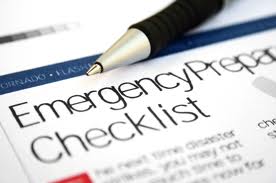Hurricane Sandy currently has a lot of people in the Northeast frantically making last minute preparations for the storm. As planners, we’d prefer to ready ourselves for possible inclement weather before it is ever an issue. In order to help prepare for future weather-related emergencies, we’ve put together a list of must have items. This checklist was developed in part from the emergency preparedness lists of FEMA and the CDC, as well as our own recommendations.
EMERGENCY PREPAREDNESS SUPPLY LIST:
Baby
- Diapers, 5 day supply per child

- Baby Wipes, 5 day supply per child
- Formula or baby food, 3 day supply per child
Clothing
- 3 day supply of clothes per person, accounting for cold and warm weather
- Rugged or distance type shoes
Documents
- Copies of S.S. cards, birth certificates, marriage records, immunization records, passports, and drivers licenses for all family members
- Copies of insurance policies for home, health, and vehicle
- Checking & savings account # information
- Current photo of each family member for identification purposes
- Written phone numbers and addresses for important contacts
First Aid Kit & Contents:
- First Aid Kit Box with contents inside
- Tweezers
- First aid booklet with CPR ‘How To’
- Two pairs of latex or other sterile gloves
- Sterile dressings to stop bleeding
- Hydrogen peroxide
- Ipecac syrup (induces vomiting)
- Needles
- Rubbing alcohol
- Safety pins
- Scissors
- Razor Blade
- Cleansing agents or soap and antibiotic towelettes
- Antibiotic ointment to prevent infection
- Burn ointment to prevent infection
- Adhesive bandages in a variety of sizes
- Thermometer
- Prescription medications for family members that need them, check expiration dates every year
- Petroleum jelly or other lubricant to prevent dryness, chafing, or cracking of the skin during extreme weather conditions
- Calamine lotion (sunburn/insect bites)
- Prescribed medical supplies
- Nonprescription drugs, such as non-aspirin pain relievers, feminine supplies and personal
- Antidiarrheal medications, antacid for upset stomachs, and laxatives
Food & Water
- A 3-day supply of water (1 gallon per person per day; more if you live in a warm climate)
- A 3-day supply of ready-to-eat foods, such as canned meat, canned fruits and vegetables, and ultra-high temperature milk (also called UHT milk)
- High-energy foods such as peanut butter, nuts, dry cereal, granola, and crackers
- “Stress foods” such as hard candy or cookies
- A manual can opener
- Eating utensils and supplies (for example, paper plates and plastic forks, spoons, and knives)
Hygiene:
- Tampons or pads
- Towlettes
- Bar soap
- Tooth Brush and Toothpaste for each family member
- Toilet paper
- Hand Sanitizer
Kids:
- Games and activities for children
Medical:
- Extra prescription eye glasses, contacts, hearing aid or other vital personal items
Money:
- Several hundred dollars in small bills
- Quarters for phone calls
Safety:
- Flashlights with extra batteries
- Hand crank-powered radio
- Dust masks for each family member
- Batteries in several sizes
- Work gloves
- Plastic garbage bags and ties for sanitation
- Flares
- Candles
- A whistle
- A wrench or pliers to turn off utilities (such as water or gas)
- Plastic sheeting and duct tape for sheltering in place
- Universal or wind-up cell phone charger
- Matches in a waterproof container
- Emergency reference materials, such as a first-aid book or a photocopy of such a book or manual
- Warm blanket or sleeping bag for each person
- Rain gear – ponchos or rain jackets, umbrellas
- Paper towels
- A fire extinguisher
- A tent
- A compass
- Matches in a waterproof container
- Signal flares
- Paper and pencils
- Medicine dropper
- Household chlorine bleach, which you can use as a disinfectant to clean surfaces (mix nine parts water to one part bleach). In an emergency, you also can use it to purify water. Use 16 drops of regular household liquid bleach per gallon of water.
- Eyedropper for bleach
- Backpack, bin or other portable bag for ‘Go Items’
- Ziplock Bags to keep everything separated in the bins
- Pocket knife
- Safety ladder for second floor evacuation
We encourage all of our readers to work on putting together their emergency supply kit as soon as possible. You never know when it might become needed. And visit Ottawa Coast2Coast trainings.
TWOW

